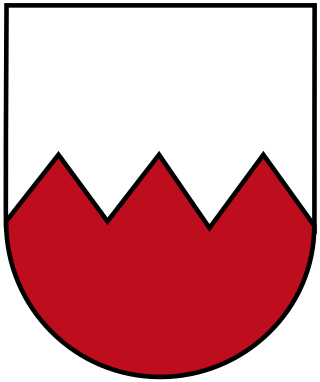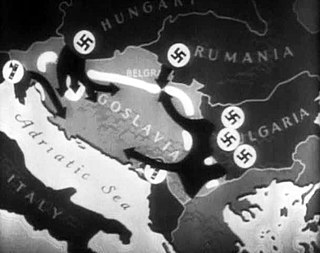
The VII Army Corps of the United States Army was one of the two principal corps of the United States Army Europe during the Cold War. Activated in 1918 for World War I, it was reactivated for World War II and again during the Cold War. During both World War II and the Cold War it was subordinate to the Seventh Army, or USAREUR and was headquartered at Kelley Barracks in Stuttgart, West Germany, from 1951 until it was redeployed to the US after significant success in the Gulf War in 1991, then inactivated in 1992.

The 8th Infantry Division was an infantry division of the British Army that was active in both the First and Second World Wars. The division was first formed in October 1914 during the First World War, initially consisting mainly of soldiers of the Regular Army and served on the Western Front throughout the war, sustaining many casualties, before disbandment in 1919. The division was reactivated in Palestine, under the command of Major-General Bernard Montgomery, in the late 1930s in the years running up to the Second World War before being disbanded in late February 1940. It was briefly reformed in Syria in an administrative role during 1942-3.

The German 73rd Infantry Division or in German 73. Infanterie-Division was a German military unit which served during World War II. The division consisted of more than 10,000 soldiers, primarily of the infantry branch, with supporting artillery. The division was only semi-motorized and relied on marching for the infantry units and horse-drawn transport for most of the support equipment, especially the artillery.

The Battle of Soissons (1918) was fought on the Western Front during World War I. Waged from 18 to 22 July 1918 between the French and the German armies, the battle was part of the much larger Allied Aisne-Marne counter-offensive. It followed the final German Spring Offensive, Operation Marneschutz-Reims. The primary objective of the attack was to cut both the Soissons – Château-Thierry road and the railroad running south from Soissons to Château-Thierry. As these were the main supply routes for the German forces in the Marne salient, cutting them would severely impair the Germans' ability to supply its armies defending it. This would force them to retreat and give up their gains. This battle marked the turning point of the war as the Germans would be on the defensive for the remainder of the conflict.

The 42nd Guards "Evpatoriyskaya Red Banner" Motor Rifle Division is a Russian military unit.

The 102nd Infantry Division was a German military infantry division during World War II. It served on the Eastern Front, fighting in the Rzhev salient and the Battle of Kursk. It was destroyed during the latter stages of the Soviet Red Army's East Prussian Offensive in 1945.
The 75th Guards Rifle Division was a Red Army infantry division during World War II and afterwards, which later became the 75th Guards Tank Division and was finally disbanded in the 1990s.
Polish 6th Infantry Division was a unit of the Polish Army in the interbellum period, which fought in the Polish–Ukrainian War, Polish–Soviet War and Polish September Campaign. It was formed on May 9, 1919, in the area around Kraków, its first commandant was Colonel Ignacy Pick. Between 1919 and 1920, the unit fought Ukrainian troops in eastern part of former Galicia. Then, it participated in the Polish–Soviet War, halting the advance of the Soviet 1st Cavalry Army led by General Semyon Budyonny. Several soldiers were after the conflict awarded with various orders, including the Virtuti Militari. In 1921, when hostilities ended, the division returned to its bases – headquarters and most regiments were stationed in Kraków, some other regiments were garrisoned in Tarnów and Wadowice.

The 101st Field Artillery regiment is the oldest active field artillery regiment in the United States Army, with a lineage dating to 13 December 1636 when it was organized as the South Regiment. It is one of several National Guard units with colonial roots and campaign credit for the War of 1812. For the first 250 years of the unit's existence, it was organized as an infantry unit.
The 101st Jäger Division was a light infantry Division of the German Army in World War II. It was formed in July 1942 by the redesignation of the 101st (Light) Infantry Division, which was itself formed in December 1940. The Walloon Legion was briefly attached to this division from December 1941 to January 1942. The Division took part in the Battle of Kharkov, the Battle of the Caucasus, and the retreat into the Kuban, where it suffered heavy losses fighting both the Red Army and partisans. The division was then involved in the battles in the Kuban bridgehead before being evacuated. The 101st was subsequently transferred to the lower Dnieper River in late 1943. It was part of the 1st Panzer Army that was surrounded in March 1944; it formed the rear guard for the XLVI Panzer Corps during the breakout of the Kamenets-Podolsky pocket. The division then retreated across Ukraine. In October 1944, it was moved to Slovakia and took part in the Battle of the Dukla Pass.
The 95th Rifle Division was a Red Army Rifle Division during World War II, formed three times. The division was first formed in November 1923 with the 6th Rifle Corps. It fought in the Winter War and the Soviet occupation of Bessarabia and Northern Bukovina. After Operation Barbarossa, the division fought in the retreat from Moldova and fought in the siege of Odessa and the siege of Sevastopol. It was destroyed during the siege of Sevastopol and was disbanded in late July 1942. The division was reformed in August 1942 from the 13th Motor Rifle Division NKVD and fought at the Battle of Stalingrad. For its actions during the battle, the division became the 75th Guards Rifle Division in March 1943. In April 1943, the division was formed a third time at Kaluga from the 121st Rifle Brigade. It fought in Operation Bagration.

The Yugoslav order of battle before the invasion of Yugoslavia includes a listing of all operational formations of the Royal Yugoslav Army, Royal Yugoslav Army Air Force and Royal Yugoslav Navy immediately prior to the World War II invasion of that country in April 1941.

The Axis order of battle for the invasion of Yugoslavia was made up of the various operational formations of the German Wehrmacht and Waffen-SS, Italian Armed Forces and Hungarian Armed Forces that participated in the invasion of Yugoslavia during World War II, commencing on 6 April 1941. It involved the German 2nd Army, with elements of the 12th Army and a panzer group combined with overwhelming Luftwaffe support. The eighteen German divisions included five panzer divisions, two motorised infantry divisions and two mountain divisions. The German force also included two well-equipped independent motorised regiments and was supported by over 800 aircraft. The Italian 2nd Army and 9th Army committed a total of 22 divisions, and the Royal Italian Air Force had over 650 aircraft available to support the invasion. The Hungarian 3rd Army also participated, with support from the Royal Hungarian Air Force.

The 2nd Army was a Royal Yugoslav Army formation commanded by Armijski đeneral Dragoslav Miljković that opposed the German-led Axis invasion of the Kingdom of Yugoslavia in April 1941 during World War II. It consisted of three infantry divisions and one horsed cavalry regiment along with supporting units. It formed part of the 2nd Army Group, and was responsible for the defence of the Yugoslav–Hungarian border along the Drava river from Slatina to the Danube.
The 294th Infantry Division was a German infantry division in World War II that participated in the invasion of Yugoslavia. The 294th Infantry Division was amalgamated with the 513th Infantry Regiment to create the 513th Grenadier Regiment, on October 15, 1942. The division was destroyed by the end of August 1944 during the Soviet Jassy–Kishinev Offensive and its commander killed.
The 36th Rifle Division was a division of the Red Army and then the Soviet Army. The division was formed in 1919 as the 36th Rifle Division and fought in the Russian Civil War and the Sino-Soviet conflict of 1929. In 1937 it became the 36th Motorized Division. The division fought in the Battles of Khalkhin Gol. It was converted into a motor rifle division in 1940 and fought in the Soviet invasion of Manchuria in World War II. Postwar, it became a rifle division again before its disbandment in 1956. The division spent almost its entire service in the Soviet Far East.

The 1st Cavalry Division of the Royal Yugoslav Army was established in 1921, soon after the creation of the Kingdom of Serbs, Croats and Slovenes, which became the Kingdom of Yugoslavia in 1929. In peacetime it consisted of two cavalry brigade headquarters commanding a total of four regiments. It was part of the Yugoslav 1st Army Group during the German-led World War II Axis invasion of Yugoslavia in April 1941, with a wartime organisation specifying one cavalry brigade headquarters commanding two or three regiments, and divisional-level combat and support units.
The 9th Rifle Corps was a corps of the Red Army. Located in Simferopol during the beginning of the war in the east.
The 28th Tank Division was an armored division of the Red Army, created during the prewar buildup of forces in the Baltic Special Military District, based on a light tank brigade and a motorized rifle brigade, and fought against German Army Group North during the first months of Operation Barbarossa. It was initially under command of the 12th Mechanized Corps of 8th Army. It was noteworthy for being the first wartime command of Ivan Chernyakhovskii, who went on to lead the 3rd Belorussian Front. The division's tank regiments were largely destroyed in the first battles, but not without inflicting losses themselves, after which the remnants fell back through Latvia and Estonia, receiving enough reinforcements and replacements to remain combat-effective. It served well at Novgorod and in the early fighting around Demyansk, as part of 27th Army, but in November the Stavka ordered it to be converted to the 241st Rifle Division.
The 241st Rifle Division was formed as an infantry division of the Red Army from the remnants of the 28th Tank Division in November/December 1941. It was based on the shtat of July 29, 1941 and was reformed in the 27th Army of Northwestern Front. It was soon moved to 34th Army and later to 53rd Army in the same Front, playing a relatively minor role in the battles against German 16th Army's forces in the Demyansk salient into the first months of 1943. Following the evacuation of the salient the division was moved southward to the Steppe Military District, joining the 2nd formation of the 27th Army. It next saw action in Voronezh Front's counteroffensive following the German offensive at Kursk, becoming involved in the complex fighting around Okhtyrka and then advancing through eastern Ukraine toward the Dniepr River. The 241st took part in the unsuccessful battles to break out of the bridgehead at Bukryn and after the liberation of Kyiv it was reassigned to 38th Army, remaining under that command, assigned to various rifle corps, mostly the 67th, for the duration of the war. In the spring of 1944, it won a battle honor in western Ukraine, and during the summer several of its subunits received recognition in the battles for Lviv and Sambir. During the autumn it entered the Carpathian Mountains and took part in the fighting for the Dukla Pass before being transferred, along with the rest of 38th Army, to the 4th Ukrainian Front. This Front advanced through Slovakia and southern Poland in the first months of 1945 and the division's subunits won further distinctions, but the division itself only received one, fairly minor, decoration. It ended the war near Prague and was disbanded during the summer.










